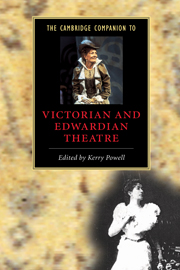Book contents
- Frontmatter
- Part 1 Introduction
- Part 2 Performance and context
- Part 3 Text and context
- 7 Comedy and farce
- 8 Encountering melodrama
- 9 The music hall
- 10 Theatre of the 1890s
- 11 New theatres for a new drama
- 12 The fallen woman on stage
- 13 Reimagining the theatre
- 14 The East-End theatre
- Select bibliography
- Index
- Series List
13 - Reimagining the theatre
women playwrights of the Victorian and Edwardian period
from Part 3 - Text and context
Published online by Cambridge University Press: 28 May 2006
- Frontmatter
- Part 1 Introduction
- Part 2 Performance and context
- Part 3 Text and context
- 7 Comedy and farce
- 8 Encountering melodrama
- 9 The music hall
- 10 Theatre of the 1890s
- 11 New theatres for a new drama
- 12 The fallen woman on stage
- 13 Reimagining the theatre
- 14 The East-End theatre
- Select bibliography
- Index
- Series List
Summary
Virginia Woolf declared as late as 1929 that bookshelves contained “no plays by women” and noted the common assumption that “women cannot write the plays of Shakespeare.” But actually there was a significant and growing number of women writing for the English theatre by the latter part of the Victorian period, and women dramatists became both more numerous and vigorously political in the early twentieth century. Not only were the denials of their existence greatly exaggerated, but the contributions of women playwrights to the Victorian and Edwardian theatre were momentous, although still not as widely recognized as they deserve to be.
As Virginia Woolf’s comment in A Room of One’s Own illustrates, women playwrights worked under a cultural assumption that they did not and could not write drama – although they were doing just that. William Archer, the leading proponent of Ibsen and Shaw, omitted any notice of women playwrights in his canon-fixing book on the development of modern drama, The Old Drama and the New (1923), although he knew several notable women dramatists personally. By saying nothing at all on the subject, Archer and many other male critics who should have known better were able to perpetuate the widespread belief that women were unequipped to become playwrights. Nevertheless, by the end of our period women dramatists were increasingly difficult to ignore, and for those with eyes to see were breaking out of the myth of their own invisibility.
- Type
- Chapter
- Information
- The Cambridge Companion to Victorian and Edwardian Theatre , pp. 237 - 256Publisher: Cambridge University PressPrint publication year: 2004
- 1
- Cited by



